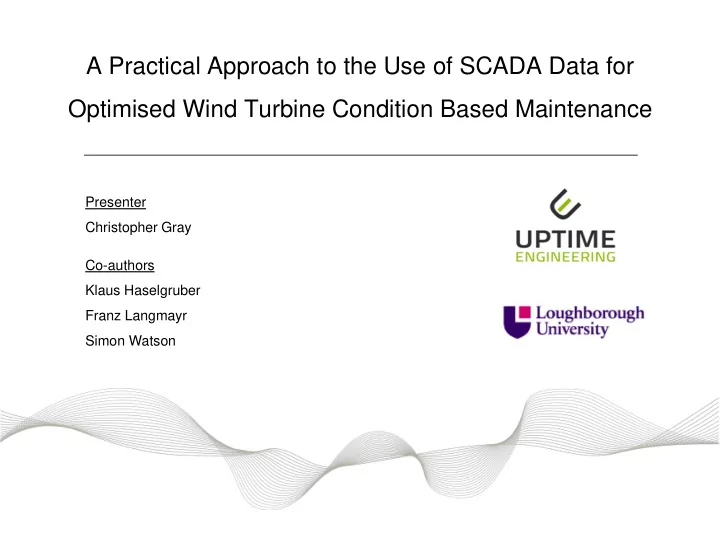

A Practical Approach to the Use of SCADA Data for Optimised Wind Turbine Condition Based Maintenance Presenter Christopher Gray Co-authors Klaus Haselgruber Franz Langmayr Simon Watson
Contents Motivation Failure Mode Assessment SCADA Data Analysis System Response Physics of Failure Workflow Summary EWEA Offshore, 1 December 2011 2
Motivation Significant contribution from several systems, range of failure modes Monitoring system required to assess overall turbine health status Specialized CMS for each system not financially viable SCADA data readily available, high level of detail in modern turbines Source: EWEC 2010 “Methodology and Results of the Reliawind Reliability Field Study“ EWEA Offshore, 1 December 2011 3
Failure Mode Assessment System analysis identify failure root causes, damage drivers and model parameters Expert input to identify key issues Input for model development & fault diagnostic algorithms link to available data EWEA Offshore, 1 December 2011 4
Limitations of SCADA 10-minute Logs Information loss for dynamic signals (Nyquist theorem) missing features Non-linear damage kinetics, error in remaining life estimates Improvement: on-line analysis, improve data aggregation Blade Pitch Activity S-N Curve (simplified example) …. 10-min log 10-min log Shock Loads Log S Signal Noise Log N EWEA Offshore, 1 December 2011 5
SCADA Data Analysis: Quick Wins Large number of turbines, large data volumes automated analysis and statements High data quality required, check for errors (sensors, signal form, drift, cross checks) System health check simple analysis techniques (statistics, correlations, trends) Early Warning of Overheating, Turbine 4 EWEA Offshore, 1 December 2011 6
System Response Modelling & Monitoring Library of models for various systems, as analysed in Failure Mode Assessment On-line comparison of measured vs expected behaviour Pitch Operation Controller alarm limit Gbox Oil Temperature Generator Winding Part load, elevated temperature Bearing Temperatures Rotor Aerodynamics Early warning Power Performance Yaw Operation November 2011 | 7 7
Prognostics, Physics of Failure SCADA log defines load history for various systems and components Models created to describe the relationship between load and damage accumulation Transfer functions generated where damage driver is not directly measured Damage driving events Rotor Blade Laminate De-bonding Gearbox Bearing High Cycle Fatigue Generator Winding Thermal Aging Drive Shaft Flange Fretting Yaw Drive Ring Gear Adhesive Wear Pitch Motor Housing High Cycle Fatigue Foundation High Cycle Fatigue EWEA Offshore, 1 December 2011
Statistics, Reporting, Actions PHYSICS Active Power Residual [kW] STATISTICS 99.9% 99.9% Gearbox Temperature Residual [ ° C] SOFTWARE EWEA Offshore, 1 December 2011 9
Statistics, Reporting, Actions Windpark: Demo 1 Date From: 01.08.2010 Date To: 31.08.2010 Feedback ACTIONS DIAGNOSIS ALARMS Turbine Inspection Response anomaly Expert system Spare parts order Performance deficit Failure mode identification Maintenance schedule High failure probability EWEA Offshore, 1 December 2011 10
Conclusions Holistic, complete life cycle approach required for WEC reliability SCADA data analysis a valuable & cost effective technique for condition monitoring Keys to Success Automated data validation, analysis, reporting Comprehensive all components and relevant failure modes Independent all WEC types Scalable single monitoring solution Effective integration into asset management program EWEA Offshore, 1 December 2011 11
Thank You!
Recommend
More recommend